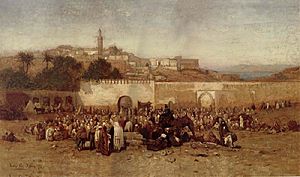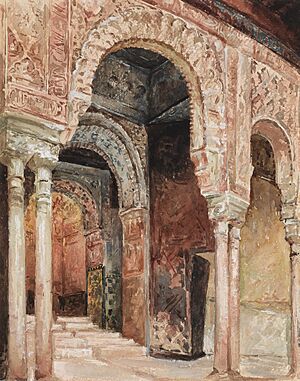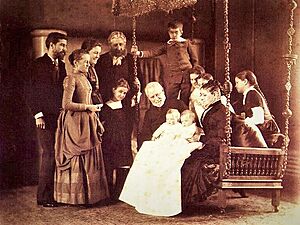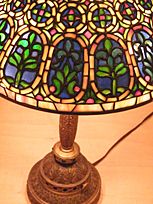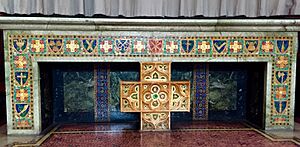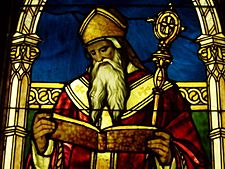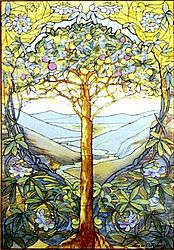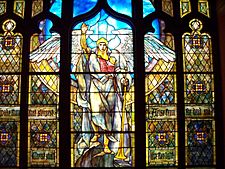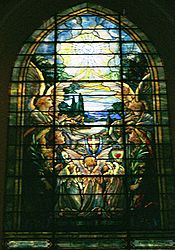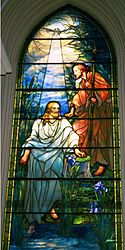Louis Comfort Tiffany facts for kids
Quick facts for kids
Louis Comfort Tiffany
|
|
|---|---|
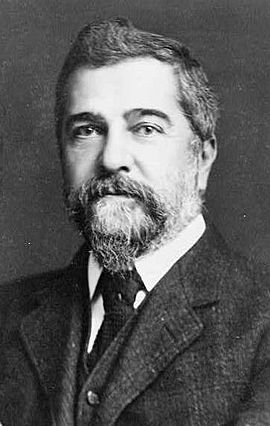
Tiffany c. 1908
|
|
| Born | February 18, 1848 New York City, U.S.
|
| Died | January 17, 1933 (aged 84) New York City, U.S.
|
| Resting place | Green-Wood Cemetery |
| Education | Pennsylvania Military Academy Eagleswood Military Academy |
| Known for | Favrile glass, Tiffany lamps |
| Spouse(s) | Mary Woodbridge Goddard (1872–1884; her death) Louise Wakeman Knox (1886–1904; her death) |
| Children | Dorothy Burlingham and seven others |
| Parent(s) | Charles Lewis Tiffany Harriet Olivia Avery Young |
| Signature | |
Louis Comfort Tiffany (born February 18, 1848 – died January 17, 1933) was a famous American artist and designer. He is best known for his amazing work with stained glass. Tiffany is a key figure in the Art Nouveau and Aesthetic art movements in America.
He was part of a talented group of designers called Associated Artists. This group included Lockwood de Forest, Candace Wheeler, and Samuel Colman. Tiffany created beautiful lamps and stained glass windows. He also designed glass mosaics, blown glass, ceramics, jewelry, and metalwork. He was the first design director for his family's company, Tiffany & Co., which his father, Charles Lewis Tiffany, started.
Contents
Early life and artistic beginnings
Louis Comfort Tiffany was born in New York City. His father, Charles Lewis Tiffany, founded the famous Tiffany and Company jewelry store. Louis went to school at Pennsylvania Military Academy and Eagleswood Military Academy.
He first trained to be a painter. He studied with artists like George Inness and Samuel Colman. He also attended the National Academy of Design in New York City. Later, he studied with a French painter named Leon-Adolphe-Auguste Belly. Belly's landscape paintings greatly influenced Tiffany's art.
A career in glass and design
Tiffany began his career as a painter. However, he became very interested in glassmaking around 1875. He worked at several glass factories in Brooklyn. In 1879, he teamed up with Candace Wheeler, Samuel Colman, and Lockwood de Forest. They formed a company called Louis Comfort Tiffany and Associated American Artists. This group designed wallpaper, furniture, and fabrics.
Later, Tiffany opened his own glass factory in Corona, New York. He wanted to create better quality glass designs. With his talent, leadership, and his father's support, his business grew quickly.
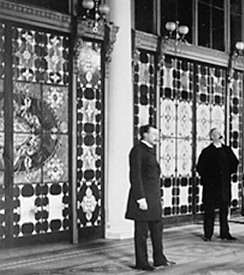
In 1881, Tiffany designed the inside of the Mark Twain House in Hartford, Connecticut. This design can still be seen today. A very famous project came in 1882. President Chester Alan Arthur asked Tiffany to redecorate the White House. The President thought the rooms were boring.
Tiffany worked on several important rooms, including the East Room and the Blue Room. He added new furniture, painted decorative patterns, and installed new fireplaces. He also used wallpaper with detailed designs. Most famously, he added Tiffany glass to light fixtures and windows. He even put in a tall, colorful glass screen in the Entrance Hall. However, these Tiffany designs were removed in 1902 during a renovation.
In 1885, Tiffany decided to focus only on art glass. He started his own glassmaking company. It was first called the Tiffany Glass Company. In 1902, it became known as Tiffany Studios.
Tiffany's unique glass techniques
Early in his career, Tiffany used cheap jelly jars and bottles. They had natural mineral bits that made them unique. When fine glassmakers wouldn't leave these "impurities" in their glass, he decided to make his own. Tiffany used opalescent glass, which has a milky, shimmering look. He used many colors and textures to create his special style of stained glass.
Tiffany also used a technique called "copper foil." With this method, each piece of cut glass is wrapped in copper foil. Then, all the pieces are soldered together. This allowed for much more detail than older methods. Traditionally, stained glass was made by painting on colorless glass and setting it in lead. Tiffany's method was a big change.
His use of colored glass to create pictures was inspired by the Arts and Crafts movement in England. Other artists like Oliver Kimberly, Frank Duffner, and John La Farge were also creating this new American style of stained glass.
Exhibitions and recognition
At the Paris Exhibition of 1889, Tiffany was very impressed by the glass work of French artist Émile Gallé. He also met the artist Alphonse Mucha.
In 1893, Tiffany built a new factory called the Stourbridge Glass Company. It was later renamed Tiffany Glass Furnaces. That same year, his company introduced the term Favrile. This word described his first blown glass creations. Some of his early lamps were shown at the 1893 World's Fair in Chicago. At the Exposition Universelle (1900) in Paris, he won a gold medal for his stained glass windows called The Four Seasons.
He officially trademarked the word Favrile in 1894. It came from an old French word meaning "handmade." He later used this word for all his glass, enamel, and pottery. Tiffany's first lamps for sale came out around 1895. His company made many stained glass windows and Tiffany lamps. They also designed full interior decorations. At its busiest, his factory had over 300 skilled artists.
Recent studies show that a team of talented women designers, often called the "Tiffany Girls," played a big role. Led by Clara Driscoll, they designed many of the famous floral patterns on Tiffany lamps and other items.
Tiffany's interiors also featured many mosaics. The mosaics workshop was mostly staffed by women.
In 1902, Tiffany became the first design director for Tiffany & Co., the jewelry company his father started.
In 1911, a huge glass curtain was made for the Palacio de Bellas Artes in Mexico City. Many people consider it a masterpiece.
Tiffany used all his design skills in his own home, Laurelton Hall. This large, 84-room house was completed in 1905 in Laurel Hollow, Long Island. Later, he gave this estate to his foundation for art students. The house was sold in 1949 and destroyed by a fire in 1957.
Family life
Louis Comfort Tiffany married Mary Woodbridge Goddard on May 15, 1872. They had four children:
- Mary Woodbridge Tiffany (1873–1963)
- Charles Louis Tiffany I (1874–1874)
- Charles Louis Tiffany II (1878–1947)
- Hilda Goddard Tiffany (1879–1908)
After Mary's death, he married Louise Wakeman Knox on November 9, 1886. They had four more children:
- Louise Comfort Tiffany (1887–1974)
- Julia DeForest Tiffany (1887–1973)
- Annie Olivia Tiffany (1888–1892)
- Dorothy Trimble Tiffany (1891–1979), who became a well-known psychoanalyst and close friend of Anna Freud.

Tiffany passed away on January 17, 1933. He is buried in Green-Wood Cemetery in Brooklyn, New York. He is the great-grandfather of investor George Gilder.
Awards and recognition
Louis Comfort Tiffany received many awards for his artistic work:
- 1893: 44 medals at the World's Columbian Exposition in Chicago.
- 1900: Gold medal and Chevalier of the Legion of Honour (France).
- 1900: Grand prix at the Paris Exposition of 1900.
- 1901: Gold medals at the St. Petersburg, Buffalo, and Dresden Expositions.
- 1902: Gold medal and special diploma at the Turin Exposition.
- 1904: Gold medal at the Louisiana Purchase Exposition in St. Louis.
- 1907: Gold medal at the Jamestown Exposition.
- 1909: Grand prize at the Seattle Exposition.
- 1915: Gold medal at the Panama Exposition.
- 1926: Gold medal at the Philadelphia Sesquicentennial Exposition.
Where to see Tiffany's art
Many museums and churches around the world display Louis Comfort Tiffany's work.
The Charles Hosmer Morse Museum of American Art in Winter Park, Florida has the largest collection of his art. This includes Tiffany jewelry, pottery, paintings, glass art, windows, lamps, and the Tiffany Chapel. Tiffany designed this chapel for the 1893 World's Columbian Exposition in Chicago. After the fair, the chapel was moved to New York City. Later, it was rescued from a fire at Laurelton Hall and now fills an entire section of the Morse Museum.
In New York City, you can see Tiffany's work at the Metropolitan Museum of Art and the New-York Historical Society. The New-York Historical Society also shares new information about the women designers, the "Tiffany Girls," who helped create his famous designs. The Queens Museum of Art has a permanent collection of Tiffany objects. This is fitting because his company's studios were once located in Corona, Queens.
The Reid Memorial Presbyterian Church in Richmond, Indiana has 62 Tiffany windows still in their original places.
In 1906, Tiffany created stained glass windows for the Madison Square Presbyterian Church in Manhattan. This was Tiffany's own church. When the church was torn down, Tiffany had arranged to get the windows back. He sent them to the Mission Inn in Riverside, California. These beautiful windows are now displayed in the inn's St. Francis Chapel.
The Arlington Street Church in Boston has 16 Tiffany windows. These were designed by Frederick Wilson, Tiffany's main designer for church windows. Also in Boston, the Frederick Ayer Mansion is one of the few remaining buildings with Tiffany's interior designs and exterior mosaics.
The Community Church of Providence in Providence, Rhode Island used to have a large Tiffany stained glass window called "Light in Heaven and Earth." This complex work was created by Agnes F. Northrop. In 2018, the church sold this window to the Art Institute of Chicago, where it will be displayed.
Outside the United States, you can find Tiffany's work in Montreal, Canada. The Montreal Museum of Fine Arts has 17 windows from a former church. The American Church in Paris has two windows that are now considered national treasures by the French government.
The Haworth Art Gallery in Accrington, England has over 140 examples of Tiffany's work. This includes vases, tiles, lamps, and mosaics. It is said to be the largest public collection of Tiffany glass outside the United States.
Gallery
- Stained glass windows
-
Window of St. Augustine, in the Lightner Museum, St. Augustine, Florida.
-
Angel of the Resurrection (1904), in the Indianapolis Museum of Art
-
The New Creation, at Brown Memorial Presbyterian Church, Baltimore, Maryland
-
Nicodemus Came to Him by Night, First Presbyterian Church, Lockport, NY
-
Christ the Consoler at Pullman Memorial Universalist Church, Albion, NY
- Tiffany Lamps
-
Collection of Tiffany Lamps from the Virginia Museum of Fine Arts
See also
 In Spanish: Louis Comfort Tiffany para niños
In Spanish: Louis Comfort Tiffany para niños
- Tiffany glass
- The Louis Comfort Tiffany Foundation
- Art Nouveau glass art


